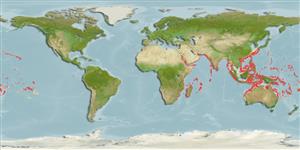Environment: milieu / climate zone / depth range / distribution range
นิเวศวิทยา
เกี่ยวกับทะเล,น้ำเค็ม เกี่ยวกับหินโสโครก; ไม่มีการอพยพย้ายถิ่น; ระดับความลึก 80 - 370 m (Ref. 5222). Tropical; 31°N - 31°S, 30°E - 134°W (Ref. 5222)
Indo-Pacific: Red Sea and East Africa to the central Pacific. Epinephelus poecilonotus, Epinephelus radiatus, and Epinephelus tuamotoensis are sometimes referred to as this species.
ขนาด / น้ำหนัก / Age
Maturity: Lm ? range ? - ? cm
Max length : 90.0 cm TL เพศผู้/กระเทย; (Ref. 2871); common length : 60.0 cm TL เพศผู้/กระเทย; (Ref. 9137); น้ำหนักสูงสุดที่มีการรายงาน: 6.7 kg (Ref. 40637)
เงี่ยงครีบหลัง (รวม): 11; ก้านครีบอ่อนที่หาง (รวม): 14-15; เงี่ยงครีบก้น 3; ก้านครีบอ่อนที่ก้น: 7 - 8. Distinguished by the following characteristics: head and body tan, with dark brown bands: bifurcate band that begins at rear edge of eye, upper branch extending to a dark brown saddle blotch on the nape just in front of dorsal fin, lower branch running to lower opercular spine and continuing on body as midlateral band that bifurcates above the pectoral fin, upper branch of this band running to a dark blotch at the base of 3rd to 7th dorsal fin rays; dark band from the upper edge of the operculum to base of 5th to 9th dorsal fin spines; narrow band from lower edge of eye to pectoral fin base, continued as broken band along lower part of body and curving up to the dorsal part of peduncle; broad band from maxillary groove to posterior end of interopercle; small dark brown spots often present in the pale areas between bands; depth of body contained 2.8-3.1 times in SL; head length 2.3-2.5 times in SL; flat to moderately convex interorbital area, dorsal head profile slightly convex; shallow indentation on preopercle just above the enlarged serrae at the angle; upper edge of operculum almost straight; maxilla reaches to or past vertical at rear edge of eye; 2 rows of teeth on midlateral part of lower jaw (Ref. 89707).
Found in deep waters from 80-370 m on slopes of islands, sea mounts or continental shelves. Feeds on benthic fishes and large invertebrates (Ref. 89707). Considered rare in Tahiti but quite common in atolls (Ref. 4821). The species is easily confused with E. poecilonotus, E. radiatus, or E. tuamotuensis, three closely related deep-water groupers. Known to be ciguatoxic at Mauritius. Uncommon in local markets (probably due to it deep-water habitat).
Life cycle and mating behavior
วัยเจริญพันธุ์ | การสืบพันธุ์ | การวางไข่ | เซลสืบพันธ์ของเพศเมีย(ไข่) | ความดกของไข่ | ตัวอ่อน
Heemstra, P.C. and J.E. Randall, 1993. FAO Species Catalogue. Vol. 16. Groupers of the world (family Serranidae, subfamily Epinephelinae). An annotated and illustrated catalogue of the grouper, rockcod, hind, coral grouper and lyretail species known to date. Rome: FAO. FAO Fish. Synop. 125(16):382 p. (Ref. 5222)
IUCN Red List Status (Ref. 130435)
Threat to humans
Reports of ciguatera poisoning (Ref. 5222)
Human uses
การประมง: มีการค้าเพียงเล็กน้อย; การตกปลาเป็นกีฬา: ใช่
ข้อมูลเพิ่มเติม
ชื่อสามัญชื่อพ้องกลไกการเผาผลาญพลังงานผู้ล่าการศึกษาเกี่ยวกับผลกระทบของสารประกอบทางเคมีที่เป็นอันตรายต่อสิ่งมีชีวิต ประชากร และสิ่งแวดล้อมการสืบพันธุ์วัยเจริญพันธุ์การวางไข่การรวมกลุ่มวางไข่ความดกของไข่เซลสืบพันธ์ของเพศเมีย(ไข่)Egg development
อ้างอิงการเพาะเลี้ยงสัตว์น้ำประวัติการเพาะเลี้ยงสัตว์น้ำสายพันธุ์พันธุศาสตร์ElectrophoresesอัตราพันธุกรรมโรคการแปรรูปNutrientsMass conversion
เครื่องมือ
Special reports
Download XML
แหล่งที่มาจากอินเตอร์เน็ต
Estimates based on models
Preferred temperature (Ref.
123201): 14.2 - 23.1, mean 19 °C (based on 305 cells).
Phylogenetic diversity index (Ref.
82804): PD
50 = 0.5000 [Uniqueness, from 0.5 = low to 2.0 = high].
Bayesian length-weight: a=0.01318 (0.00806 - 0.02156), b=3.03 (2.90 - 3.16), in cm total length, based on LWR estimates for this species & Genus-body shape (Ref.
93245).
ระดับชั้นอาหาร (Ref.
69278): 4.0 ±0.65 se; based on food items.
Generation time: 5.0 ( na - na) years. Estimated as median ln(3)/K based on 1
growth studies.
ความสามารถในการกลับคืนสู่ปกติ (Ref.
120179): ขนาดกลาง, เวลาต่ำสุดที่จะทำให้ประชากรเพิ่มขึ้นเป็น 2 เท่าใช้เวลา 1.4 - 4.4 ปี (Preliminary K or Fecundity.).
Fishing Vulnerability (Ref.
59153): Moderate vulnerability (43 of 100).
Climate Vulnerability (Ref.
125649): Very high vulnerability (86 of 100).
Nutrients (Ref.
124155): Calcium = 18.5 [8.7, 39.6] mg/100g; Iron = 0.44 [0.23, 0.88] mg/100g; Protein = 18.6 [17.1, 20.0] %; Omega3 = 0.138 [0.085, 0.226] g/100g; Selenium = 58.6 [32.9, 107.1] μg/100g; VitaminA = 123 [34, 423] μg/100g; Zinc = 1.01 [0.70, 1.43] mg/100g (wet weight);
